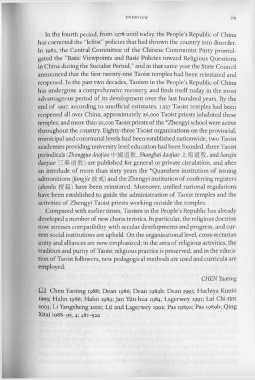Page 215 - The Encyclopedia of Taoism v1_A-L
P. 215
OV E RV I EW 175
In the fourth period, from 1978 until today, the People's Republic of China
has corrected the "leftist" policies that had thrown the country into disorder.
In 1982, the Central Committee of the Chinese Communist Party promul-
gated the "Basic Viewpoints and Basic Policies toward Religious Questions
in China during the Socialist Period," and in that same year the State Council
announced that the first twenty-one Taoist temples had been reinstated and
reopened. In the past tWo decades, Taoism in the People's Republic of China
nas undergone a comprehensive recovery, and finds itself today in the most
advantageous period of its development over the last hundred years. By the
end of 1997, according to unofficial estimates, 1,557 Taoist temples had been
reopened all over China; approximately 26,000 Taoist priests inhabited these
temples; and more than 50,000 Taoist priests of the *Zhengyi school were active
throughout the country. Eighty-three Taoist organizations on the provincial,
municipal and communal levels had been established nationwide, two Taoist
academies providing university level education had been founded, three Taoist
periodicals (Zhongguo daojiao $ ~ ill ffr.., Shanghai daojiao L #iJ iEt ffr.. , and Sanqin
daojiao = *i1tffr..) are published for general or private circulation, and after
an interlude of more than sixty years the *Quanzhen institution of issuing
admonitions lfangjie 1i!l. if.X:) and the Zhengyi institution of conferring registers
(shoulu tf~) have been reinstated. Moreover, unified national regulations
have been established to guide the administration of Taoist temples and the
activities of Zhengyi Taoist priests working outside the temples.
Compared with earlier times, Taoism in the People's Republic has already
developed a number of new characteristics. In particular, the religious doctrine
now stresses compatibility with secular developments and progress, and cur-
rent social institutions are upheld. On the organizational level, cross-sectarian
unity and alliances are now emphasized; in the area of religious activities, the
tradition and purity of Taoist religious practice is preserved; and in the educa-
tion of Taoist followers, new pedagogical methods are used and curricula are
employed.
CHEN Yaoting
W Chen Yaoting 1988; Dean 1986; Dean 1989b; Dean 1993; Hachiya Kunio
1995; Hahn 1986; Hahn 1989; Jan Ytin-hua 1984; Lagerwey 1991; Lai Chi-tim
2003; Li Yangzheng 2000; Lii and Lagerwey 1992; Pas 1989a; Pas 1989b; Qing
Xitai 1988-95, 4: 481- 520

